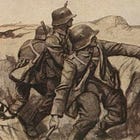In Storm Troop Tactics, I characterized the use of portable steel shields in offensive actions as a short-lived artifact of the early days of trench warfare. Such devices, I wrote, had proved far too heavy to be carried by men taking part in trench raids or ‘attacks with limited objectives’. Recently, however, I ran into a photo that challenges that view. This picture, pasted to a card that dates it to the summer of 1916, shows a scene in which German soldiers, dressed like members of an assault battalion of the second half of the First World War, appear to be training with small pieces of armored plate. (Two of these men are pointing pistols through apertures in the plates placed in front of them. A third seems ready to throw a hand grenade of the potato-mashing persuasion.)
A quick visit on the digital dragon’s hoard made available by the German Federal Archives turned up a pamphlet, promulgated by the Prussian War Ministry on 28 March 1915, that provided a well-illustrated description of the type of shield shown in the photograph. (The pamphlet, and the cover letter sent with it, can be foundin this folder, beginning on the sheet stamped ‘31’.)
The pamphlet made it clear that the shield in question had been designed to protect men armed with rifles firing in the prone position. To this end, it was provided with an aperture (through which the rifleman might fire) and a simple support (which freed the Schütze from the need to hold the shield in position while he fired.) (These are more easily seen in the picture at the top of this page than in the ones, taken from the pamphlet, that appear below.)

Subsequent searches proved less fruitful. A a series of condign keyword searches on the website of the Digital State Library of Upper Austria [Die digitale Landesbibliothek Oberösterreich] taught me a great deal about many things. (I found, for example, an excellent collection of digital copies of German language histories of regiments that served in the armies of the Hapsburg Empire.) Likewise, a search through the three histories of German assault battalions [Sturmbataillone] on my hard drive sparked lots of ideas for articles for The Tactical Notebook. Unfortunately, none of the insights that I gleaned had anything to do with hand-carried pieces of bullet-proof metal.
For Further Reading:
To Share, Subscribe, or Support:







This looks like something to have WW1 reenactors use when out in the field. I would guess it was not used due to weight. At best you would soak a bullet or shrapnel, then drop it.